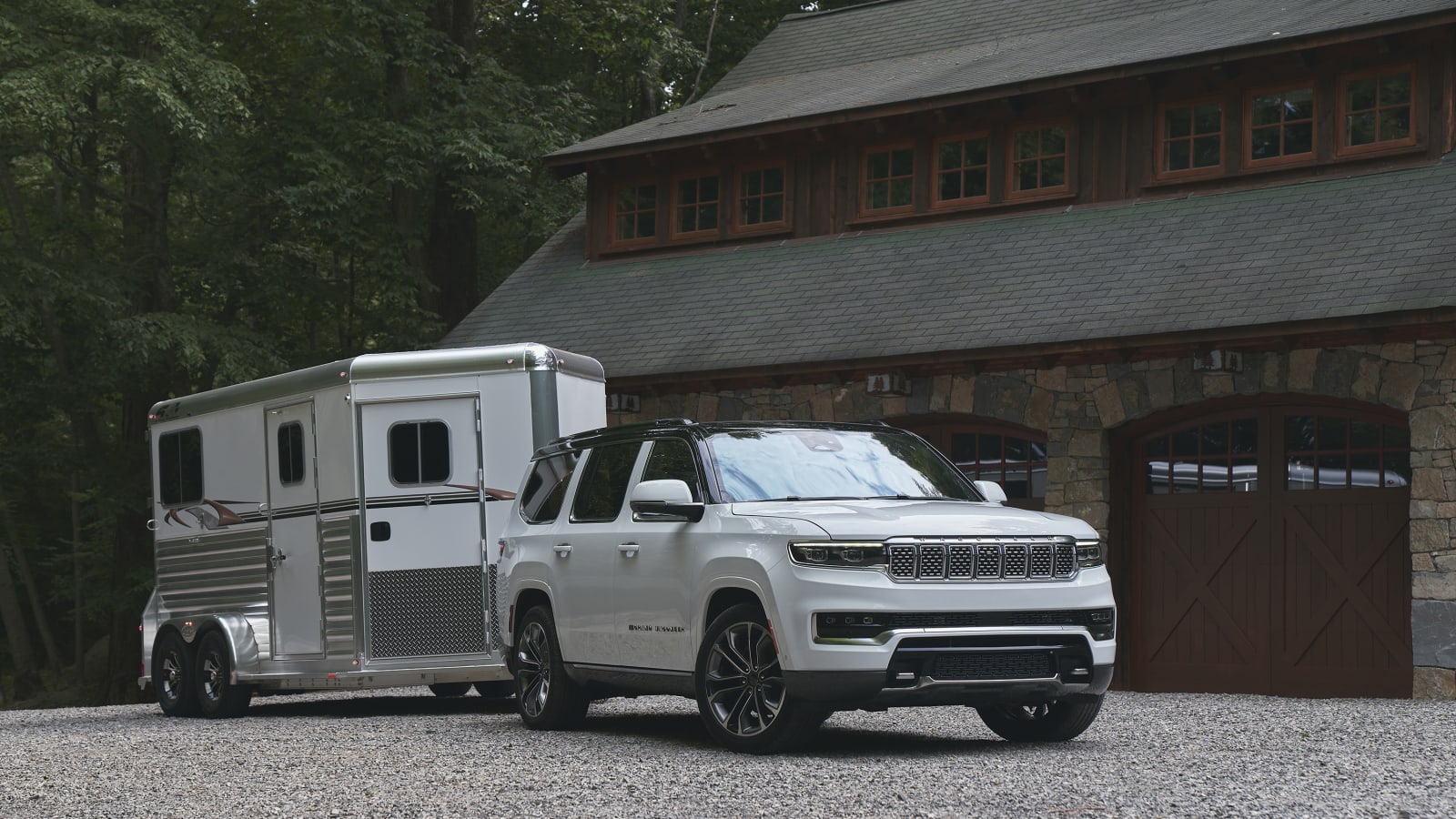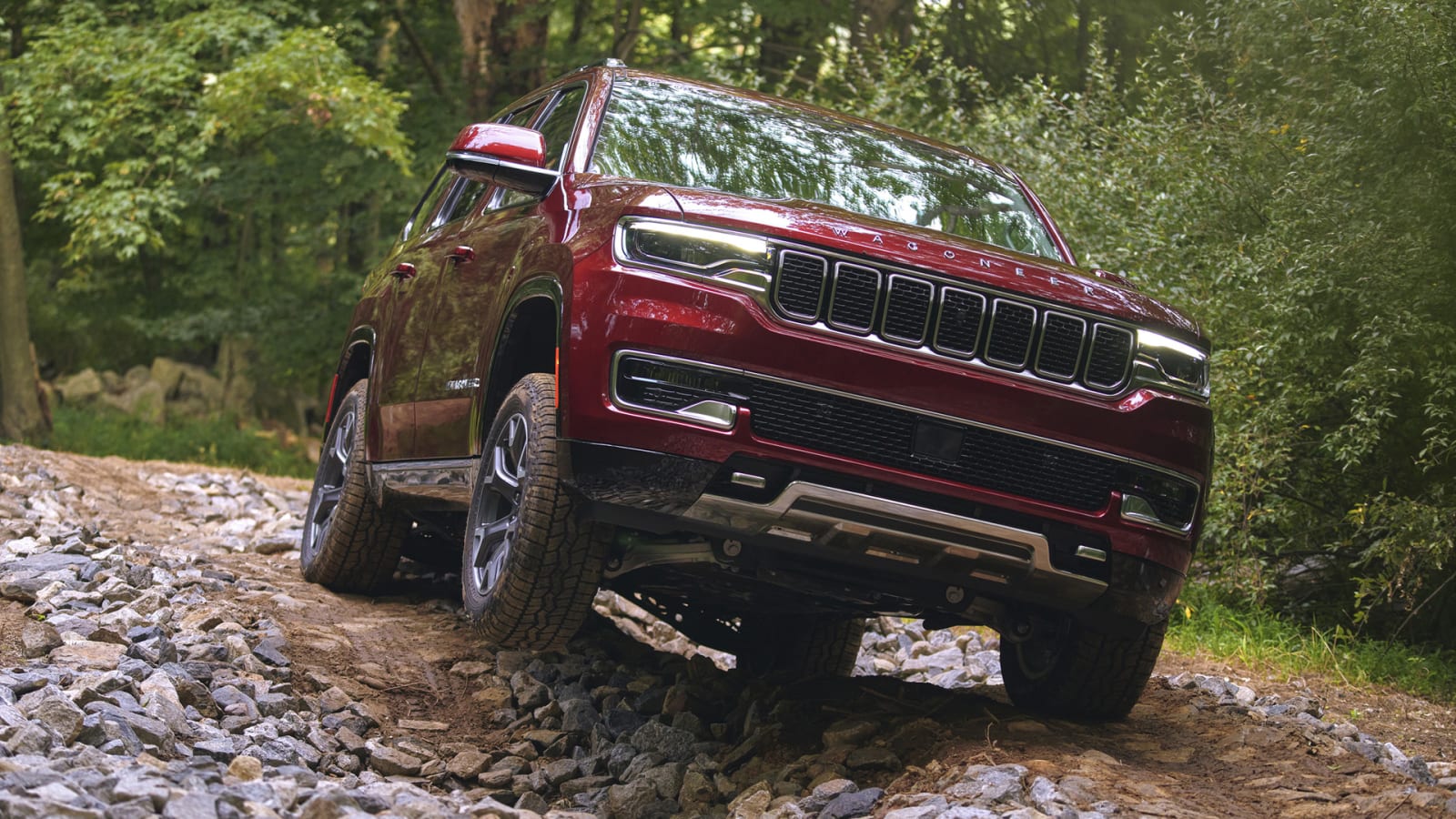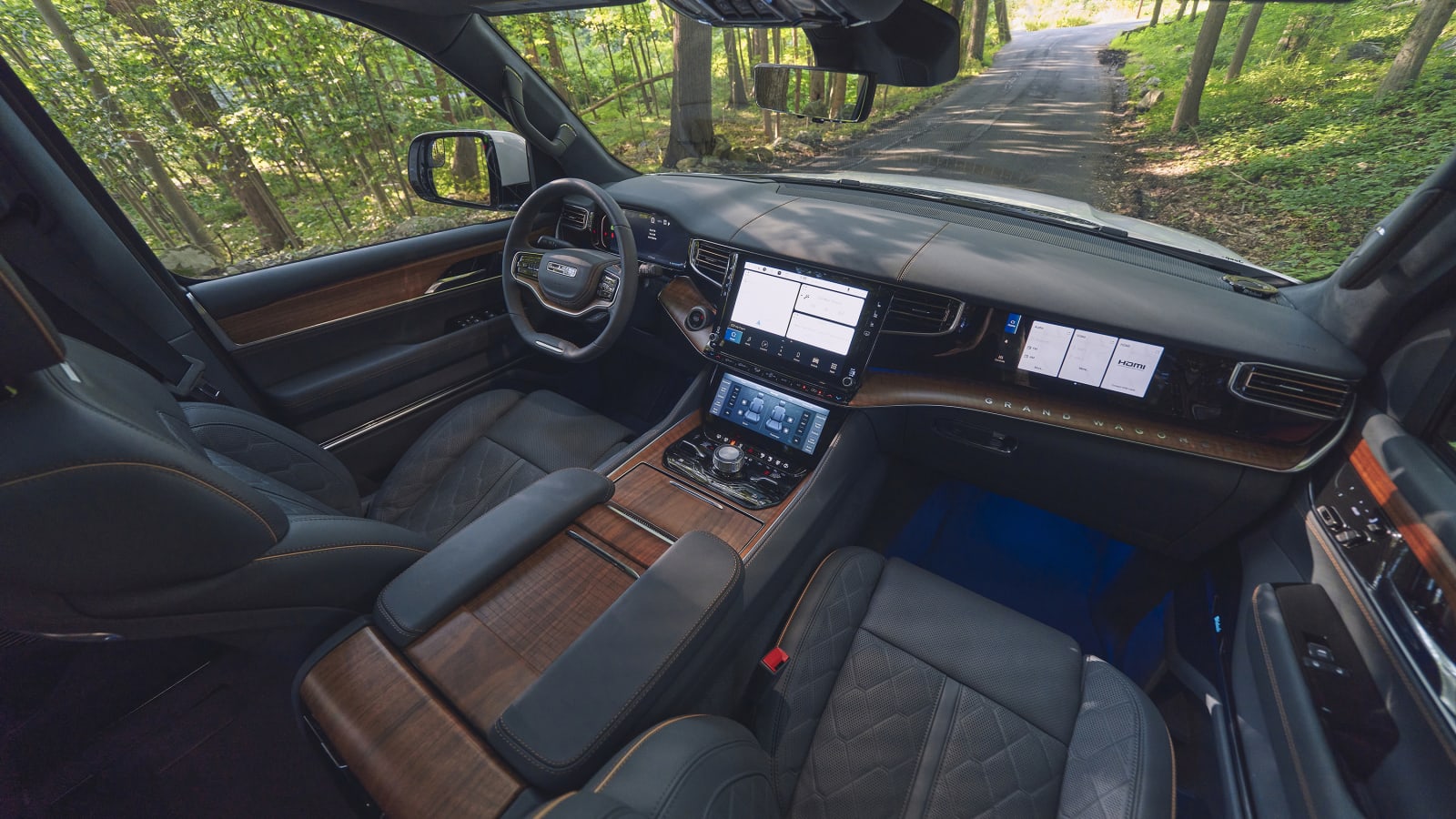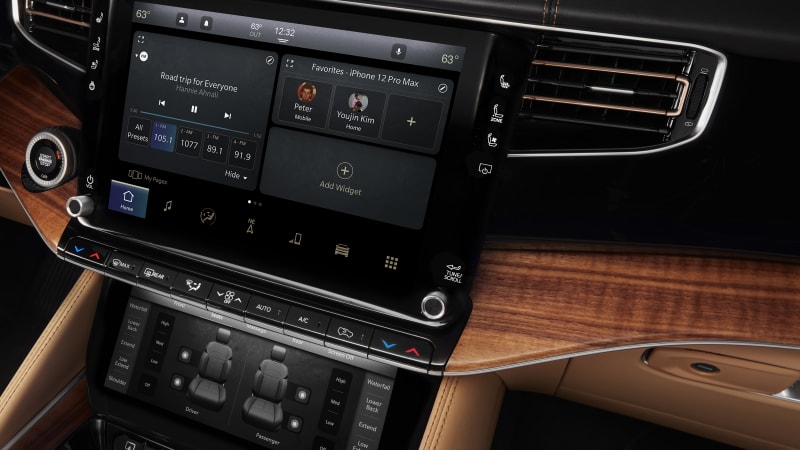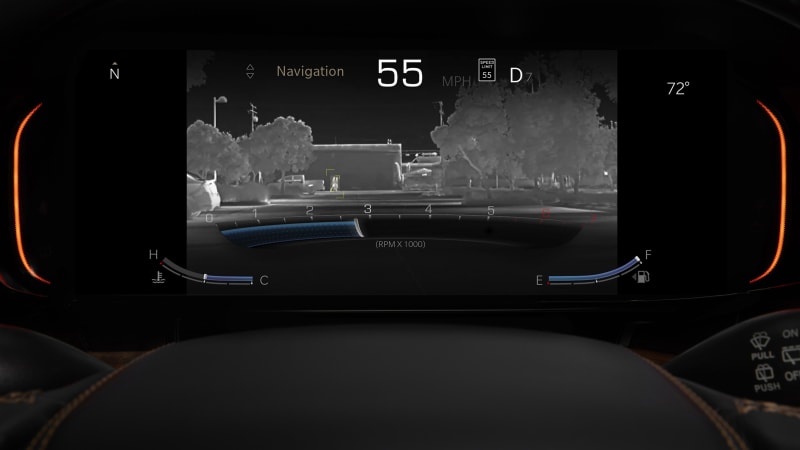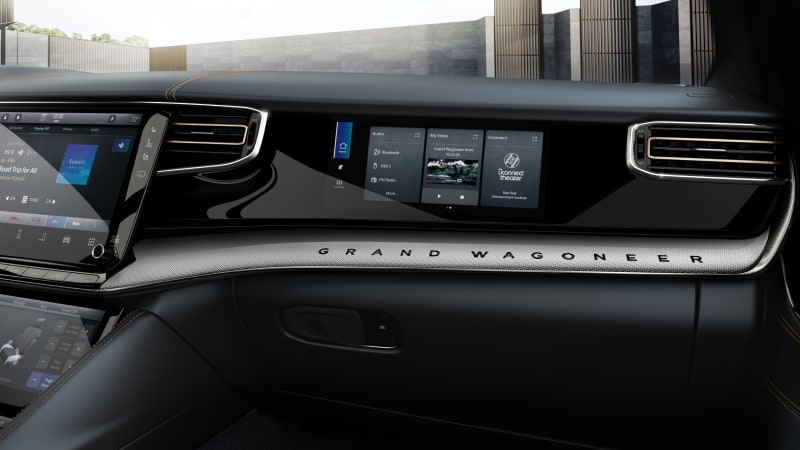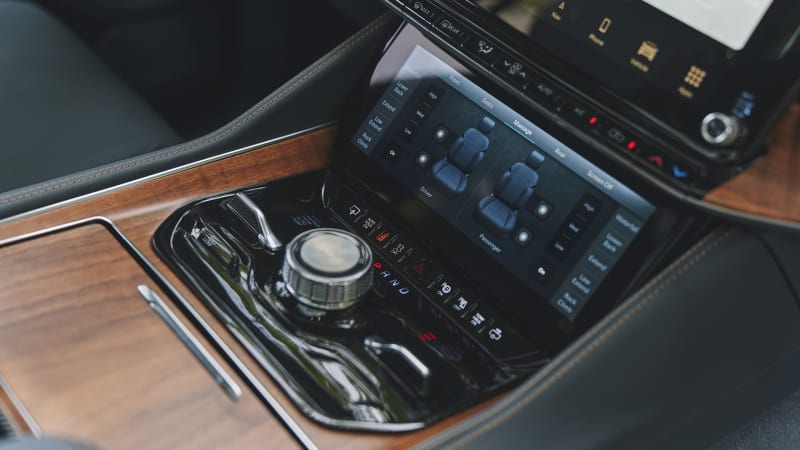Chrysler, or whatever it was known as at any given time, has been puzzlingly slow to get into the big-SUV game. That it finally decided to do so under the Jeep brand (rather than, say, Ram) and with the Wagoneer nameplate makes sense — the nameplate’s history buys instant credibility. The Wagoneer/Grand Wagoneer has been a long time coming. It was a fixture of former FCA CEO Sergio Marchione’s future product presentations and was originally supposed to appear in 2014. It’s unclear why Jeep dithered for so long.
It definitely wasn’t to create something revolutionary. The Wagoneer hews to convention in many ways. It’s built on the modified frame of the highly regarded Ram 1500 pickup, although with an independent rather than a live-axle rear suspension. A pair of off-the-shelf naturally aspirated V8s provide the power. An eight-speed automatic handles shifting duties, and although the Wagoneer comes standard with rear-wheel drive, most will be equipped with one of Jeep’s existing four-wheel-drive systems.
Its size, obviously, is not something we’ve seen attempted by Jeep, Ram or anything in the Stellantis portfolio. At 214.7 inches in length and with a 123-inch wheelbase, the Wagoneer duo is slightly larger than the standard-size Ford Expedition/Lincoln Navigator and Chevrolet Tahoe/Cadillac Escalade. Three-row seating is, naturally, standard. With the third row in use, the Wagoneer has more luggage space than its rivals, with a genuinely useful 27.4 cubic feet. Its maximum cargo volume varies with equipment, but essentially straddles the FoMoCo SUVs and runs shy of the GMs. All those dimensions are for the standard-wheelbase variants, which launch now. There also will be extended-length versions of both models, mirroring the offerings of GM and Ford.
The Wagoneer, pictured above, is intended to compete against mainstream-brand SUVs, while the Grand Wagoneer (pictured in the top gallery) pushes upmarket to take on the luxury nameplates. The visual differences between them are subtle. The two are differentiated by their grille design, front fascia, lighting, hood, wheels, and liftgate trim. The most obvious point of difference, though, is the black roof that’s exclusive to the Grand Wagoneer. Neither model has any Jeep badging, part of the effort to push them upmarket.
As ever, styling is subjective, but it’s hard not to think that Jeep was less successful in conjuring the spirit of the Wagoneer’s iconic predecessor than Land Rover was in its redo of the Defender or Ford in its resurrection of the Bronco. The Jeeps’ lead exterior designer points to the upright pillars, tall side windows, and metal-finished grille as elements that reference the original Wagoneer, which debuted as a 1963 model and was last sold in 1991.
The 2022 Grand Wagoneer is powered by the Stellantis 6.4-liter V8, here with new intake and exhaust manifolds and a specific exhaust system. It puts out 471 horsepower and 455 lb-ft of torque. Those horsepower numbers better GM’s 6.2-liter in the Cadillac Escalade/GMC Yukon/Chevrolet Tahoe and the 3.5-liter turbo V6s in the Ford Expedition and Lincoln Navigator. The 6.4’s torque output, however, trails those competitors.
The regular Wagoneer uses the corporate 5.7-liter Hemi V8, which is rated at 392 horsepower and 404 lb-ft of torque. Its eTorque mild-hybrid system features a belt-driven generator and a small lithium ion battery (charged via regenerative braking) and can add a brief boost of 130 lb-ft. It also enables engine shut-off when decelerating.
Even with that modicum of fuel-saving tech, the rear-drive Wagoneer’s EPA estimates are 16 mpg city and 22 mpg highway, with the 4WD version at 15/20 mpg. The 6.4-liter 4WD Grand Wagoneer is a thirsty beast at 13/18 mpg. Those numbers aren’t much lower than a Cadillac Escalade’s 6.2-liter gas-powered V8, but its consumption is considerably worse than GM’s 5.3-liter V8 and diesel-powered offerings as well as Ford’s EcoBoost V6s.
Don’t just blame the big Jeep’s engines, though. Its curb weights are crushing. The Wagoneer 4×2 is just barely under three tons at 5,960 pounds, and the Grand Wagoneer can hit 6,420 pounds. The Escalade, by contrast, ranges from 5,635 to 6,015 pounds.
That doesn’t prevent a hefty towing capacity, however. The rear-drive Wagoneer tows 10,000 pounds; subtract 150 from that total for the 4WD version or for Grand Wagoneer, despite its larger engine. Either way, those figures are tops in the class, eclipsing the Expedition (9,300 pounds), Navigator (8,700), Tahoe (8,400), and Escalade (8,200), as well as all the Europeans. A class IV receiver hitch is standard, and an available heavy-duty trailer-tow package includes upgraded engine cooling, a trailer-brake controller, a hitch zoom camera, and hitch line-up assist — but no automated steering assist for backing up with a trailer.
Typical of Jeep, there is more than one available four-wheel-drive system. The Wagoneer comes standard with rear-drive, and offers Quadra-Trac I or Quadra-Trac II as options. The JGW comes standard with Quadra-Drive II (although a peek at fueleconomy.gov indicates that it, too, will offer a rear-drive version). Quadra-Trac I has a single-speed transfer case; the other two get a selectable low range, with Quadra-Drive II adding electronic controls to the mechanical limited-slip rear differential.
Unlike most Jeeps, there is no off-road-oriented Trailhawk (no Wagoneer is even Trail Rated), making the most capable version a Wagoneer with the Advanced All-Terrain Group. That package, not available on Grand Wagoneer, brings a two-speed transfer case, air springs, skid plates, a 3.92:1 rear axle ratio, off-road speed control, tow hooks and 18- or 20-inch wheels with all-terrain tires.
We drove a so-equipped Wagoneer on a short off-road course specifically laid out to show off the big Jeep’s abilities. Axle articulation isn’t as great as in more hardcore Jeeps — a couple of times we were left with a tire hanging in the air — but the Wagoneer, which has 10 inches of ground clearance with the air suspension on its tiptoes (or 8.3 inches with the fixed suspension), nonetheless clambered over the rocks and dips without wheelspin or hesitation. And a feature called Active 4 Low (on both of the upper 4WD systems) also allowed it to maneuver around the tight turns in low range without crabbing.
The rest of our drive time was in the Grand Wagoneer. With its 6.4-liter V8, acceleration is certainly adequate, though it’s not on the frenetic level of the Grand Cherokee SRT with the same engine. Instead, the 6.4-liter is smooth and quiet; the accelerator is linear in its response; and the eight-speed automatic’s shifting is utterly unobtrusive. Because Jeep uses a dial shifter, manually downshifting — or, more accurately, setting a maximum gear — is done via buttons on the steering wheel.
Air springs and adaptive dampers are standard on the Grand Wagoneer (and optional on the Wagoneer), and they deliver impressive ride quality. Driving north out of New York City, we were on the West Side Highway and, later, the Saw Mill River Parkway, both older highways with storm drains at the edge of the lane, sometimes considerably below the pavement level. In some sections, you hit one after the other, and the Grand Wagoneer acknowledged them with a single body motion, and that’s it. There was no head toss and no shudder through the structure. A goodly portion of this vehicle’s considerable mass must have gone toward structural rigidity, because the GW felt solid no matter what patched and pockmarked pavement we traversed. The adaptive dampers also effectively quell body motions, but toggling between Sport and the default Auto drive modes didn’t make much discernable difference. The drive modes only affect the powertrain and suspension, not the steering, so cranking the two-spoke steering wheel always remains a low-effort affair.
No-effort steering is possible with the Highway Assist System, which is Jeep’s adaptive cruise control with lane-centering that’s exclusive to the Grand Wagoneer. It did a capable job keeping the big SUV centered in its lane with just a hand on the wheel, except on the Saw Mill’s sharper curves, when it alerted the driver to retake steering duties. We’re told a hands-free, GM Super Cruise–style semi-autonomous system is coming, but as to timing, Jeep officials would only say “soon.”
The Grand Wagoneer cabin features a wealth of rich-looking materials, including the vast expanses of wood shown above. Predictably, the Wagoneer has fewer leather-wrapped surfaces and less-intricate detailing, but at least leather is standard fare, which is typically not the case elsewhere. Critically for a road-trip vehicle, stowage is plentiful including an available cool box under the front center armrest — or, alternately, a keypad-lockable safe.
Jeep claims best-in-class second- and third-row legroom, and indeed, with the front seat set for a 6-foot driver, there’s oceans of legroom in row two and more than adequate legroom and headroom in row three. With more hip room than either the Escalade or Navigator, the Grand Wagoneer third row also feels genuinely viable for three-across seating. And here’s a rarity: The third row actually has padded armrests (in the GW, not the Wagoneer). Back-benchers also get USB outlets on both sides, and those are among the eight to 11 total USB outlets scattered throughout the cabin. Note that each provides the choice of using either a USB-A or USB-C output.
For the Wagoneer and particularly the Grand Wagoneer, screens are the defining element of the interior. While the sheer number of them seems excessive, the main ones that you interact with are extremely well done.
There’s the central infotainment display (10.1 inches in the Wagoneer and 12 inches in the Grand shown above left) and the standard digital instrument cluster (10.25 inches in the Wagoneer and 12.3 inches in the Grand shown above right). Some models also have touchscreens dedicated to the climate control system in the front and in the rear. One can also spec a touchscreen for the front passenger and a rear-seat entertainment system with dual 10.1-inch screens and Amazon Fire streaming TV capability among other media options. So, seven in total — and that’s not even counting the digital rear camera mirror or the head-up display.
For the two main screens, configurability is the watchword. We’ll start with the digital instrument cluster, which goes far beyond the typical choice between “sporty” or “classic” renditions of gauges. A full-screen display of the navigation map is possible, as in some other cars, but there are also six other functions that can take pride of place, such as night vision (for cars so equipped), off-road info, or audio. One can further tweak the layout by having a shrunken speedo and tach appear at the far edges of the screen, or opt for a digital speed readout up top and a band-style tach at the bottom. And then you can pick what additional readouts live at the very top of the screen. Naturally, setting all this up using four-way buttons on the steering wheel isn’t easy (even for the guy who designed it and was demonstrating it all for us). Plan on spending a fair bit of driveway time learning your way around the system and setting up your preferred layout.
The central display is more conventionally configurable, with the home screen able to show two, three or four functions. Multiple home pages can be saved, and you swipe to move from one to another. Additionally, there are touch-sensitive buttons to take you to main functions. You also have some say over what’s in the dock-like band of icons across the top of the screen — one item you’ll want to put up there is the camera (since there’s no physical button to call it up) plus maybe the fam-cam in-cabin camera. There’s also wireless Apple CarPlay/Android Auto with the necessary wireless charging to go with it.
The optional front passenger display seems a little like overkill. It, too, has a customizable home page and can show audio info, navigation, the cameras, and the video player (a privacy screen prevents the driver from being able to view it). Then there are the front and rear climate-control touchscreens, which also smack of excess, although Jeep is not the only manufacturer to use them. Helpfully, there’s also a row of physical buttons for frequently used climate-control functions.
So, there are many capabilities. How is it in practice? The larger digital cluster and central display look great. The graphics are as modern and sharp as any out there, and the amount of customization actually is useful, even if the setup is a little daunting. We did experience a few bugs, however, in our pre-production cars. The tuning knob was sometimes laggy in scrolling through satellite radio stations, the map in the instrument cluster refused to load, and the volume knob briefly went on strike. Here’s hoping all the many features work smoothly in the salable units. And of course, the inevitable updates can be performed over-the-air.
For owners puzzled by the in-car tech, or with other questions about the vehicle, “Wagoneer Ambassadors” are standing by to help. These dedicated customer service reps are available to answer questions during and after the purchase process and are part of Jeep’s push to elevate the ownership experience in order to compete with Cadillac, Lincoln, Mercedes-Benz, and other six-figure SUVs. Jeep is also offering vehicle pickup and dropoff for service, with the cars washed and cleaned upon return.
Dealers will similarly need to up their game, as pricing for these vehicles pushes the boundaries for the Jeep brand. Starting prices, including the $2,000 destination charge (!), are $59,995 for the Wagoneer Series I (with delayed availability), $69,995 for the Series II and $75,590 for the Series III. The Grand Wagoneer comes in Series I, Series II, Obsidian (dark exterior trim), and Series III grades, and here starting figures range from $88,995 to $105,995.
As fans of the classic Grand Wagoneer, we might have liked if this new version drew a stronger line to the original (though stopping short of plasti-wood siding). For most buyers, though, the combination of stretch-out space, a luxe interior, a pleasant driving experience, and stout towing capability are certainly enough to earn this Jeep its share of the lucrative market. We just can’t help but wonder: What took so long?
Related Video:

